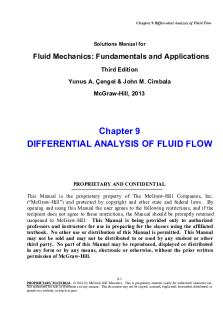Photocatalysis - Fundamentals and Applications PDF20160225-3537-TMDRB4

| Title | Photocatalysis - Fundamentals and Applications |
|---|---|
| Author | Nick Serpone |
| Pages | 1 |
| File Size | 102.2 KB |
| File Type | PDF20160225-3537-TMDRB4 |
| Total Downloads | 714 |
| Total Views | 847 |
Summary
Znorgnnica Chimicu Acta, 177 (1990) 145 145 Book Review Photocatalysis - Fundamentals and kinetic aspects of photocatalysis are discussed in Ch. Applications 6 (15 pp., 46 refs.) by M. Schiavello and A. Sclafani. Edited by Nick Serpone and Ezio Pelizzetti, published The problems related to the use o...
Description
Znorgnnica Chimicu Acta, 177 (1990) 145 Book Review 145 Photocatalysis - Fundamentals and Applications Edited by Nick Serpone and Ezio Pelizzetti, published by Wiley, New York, 1989, pp. 650, f47.50. Photochemistry is a natural phenomenon as old as the world, and also a modern branch of science, at the interface between light and matter and at the crossroads of chemistry, physics and biology. Photochemistry is of paramount importance to life (photosynthesis, vision, phototaxis, etc.) as well as to technology (image reproduction, photocatalysis, photodegradation, etc.). In the last decade photochemistry has reached a remarkable level of experimental and theoretical efficacy and it is currently developing along several lines. One of these lines is that concerning photocatalysis, defined as 'acceleration of a photoreaction by the presence of a catalyst'. The 18 chapters of this book, all written by well known experts, show how broad, interesting, and interdisciplinary is this research field. At least the following branches of chemistry and physics are directly involved in photocatalysis: spectroscopy, kinetics, thermodynamics, electrochemistry, surface science, solid state physics, and colloid chemistry. Photocatalysis has also a deep impact on several problems of applicative interest such as solar energy conversion and purification of the environment. The book begins with a short chapter (8 pp., 23 refs.) in which H. Kisch discusses the meaning of the term 'photocatalysis'. Chapter 2 (33 pp., 39 refs.), by F. Scandola and V. Balzani, deals with the fundamental concepts of photochemistry and makes a comparison between excitation of molecular species and semiconductors. N. S. Lewis and M. L. Rosenbluth cover the theory of semiconductor materials (Ch. 3,53 pp., 111 refs.) and the preparation and characterization of semiconductors (Ch. 4, 23 pp., 89 refs.). Chapter 5 (35 pp., 121 refs.) by M. Graetzel presents the state of research in the field of colloidal semiconductors. The thermodynamic and kinetic aspects of photocatalysis are discussed in Ch. 6 (15 pp., 46 refs.) by M. Schiavello and A. Sclafani. The problems related to the use of supports for photocatalysts are treated by H. Van Damme in Ch. 7 (40 pp., 95 refs.). The relevance of adsorption and desorption phenomena to photocatalytic processes is discussed by P. Pichat and J. M. Herrmann (Ch. 8, 34 pp., 144 refs.). A discussion of photocatalysis from the point of view of surface science is presented by G. A. Somorjai in Ch. 9 (58 pp., 117 refs.). Heterogeneous photocatalysis at liquid-solid interface is the topic treated by T. Sakata in Ch. 10 (28 pp., 93 refs.). H. Tributsch gives a review of photoelectrocatalysis in Ch. 11 (45 pp., 136 refs.). Chapter 12 (35 pp., 146 refs.) by D. Meisel and M. S. Matheson deals with photocatalytic processes in organized assemblies. The mechanistic aspects of photocatalysis in organic synthesis are discussed by M. A. Fox in Ch. 13 (35 pp., 77 refs.) and the mechanistic implications in surface photochemistry are illustrated by H. Al-Ekabi and N. Serpone in Ch. 14 (31 pp., 71 refs.). The extensive use of transition metal complexes in photocatalysis is reviewed by F. Chanon and M. Chanon in Ch. 15 (51 pp., 421 refs.). Three important topics of applicative interest are discussed in the last three chapters: selective activation of small molecules (Ch. 16, by P. C. Ford and A. F. Friedman, 24 pp., 99 refs.), photocatalysis in energy production (Ch. 17, by V. N. Parmon and K. I. Zamaraev, 36 pp., 30 refs.) and water purification (Ch. 18, by D. F. Ollis, E. Pellizzetti and N. Serpone, 34 pp., 11 refs.). The book ends with a reasonably detailed subject index. In conclusion, this book is an important resource for those working in the field of photocatalysis. It may also be quite useful as a textbook for advanced courses dealing with photochemistry and catalysis. Vincenzo Balzani G. Ciamician Chemistry Department University of Bologna Italy Elsevier Sequoia/Printed in Switzerland...
Similar Free PDFs

Distillation Operation and Applications
- 467 Pages

FORESTRY PRINCIPLES AND APPLICATIONS
- 31 Pages

Rizzoni G Principles and Applications
- 966 Pages

linear algebra and its applications
- 82 Pages

Fundamentals Questions AND Rationale
- 23 Pages

Rest and Sleep- Fundamentals
- 4 Pages
Popular Institutions
- Tinajero National High School - Annex
- Politeknik Caltex Riau
- Yokohama City University
- SGT University
- University of Al-Qadisiyah
- Divine Word College of Vigan
- Techniek College Rotterdam
- Universidade de Santiago
- Universiti Teknologi MARA Cawangan Johor Kampus Pasir Gudang
- Poltekkes Kemenkes Yogyakarta
- Baguio City National High School
- Colegio san marcos
- preparatoria uno
- Centro de Bachillerato Tecnológico Industrial y de Servicios No. 107
- Dalian Maritime University
- Quang Trung Secondary School
- Colegio Tecnológico en Informática
- Corporación Regional de Educación Superior
- Grupo CEDVA
- Dar Al Uloom University
- Centro de Estudios Preuniversitarios de la Universidad Nacional de Ingeniería
- 上智大学
- Aakash International School, Nuna Majara
- San Felipe Neri Catholic School
- Kang Chiao International School - New Taipei City
- Misamis Occidental National High School
- Institución Educativa Escuela Normal Juan Ladrilleros
- Kolehiyo ng Pantukan
- Batanes State College
- Instituto Continental
- Sekolah Menengah Kejuruan Kesehatan Kaltara (Tarakan)
- Colegio de La Inmaculada Concepcion - Cebu








![Fluid Mechanics Fundamentals and Applications 3rd Edition [Cengel and Cimbala 2014]](https://pdfedu.com/img/crop/172x258/zy6vgx6k618j.jpg)
